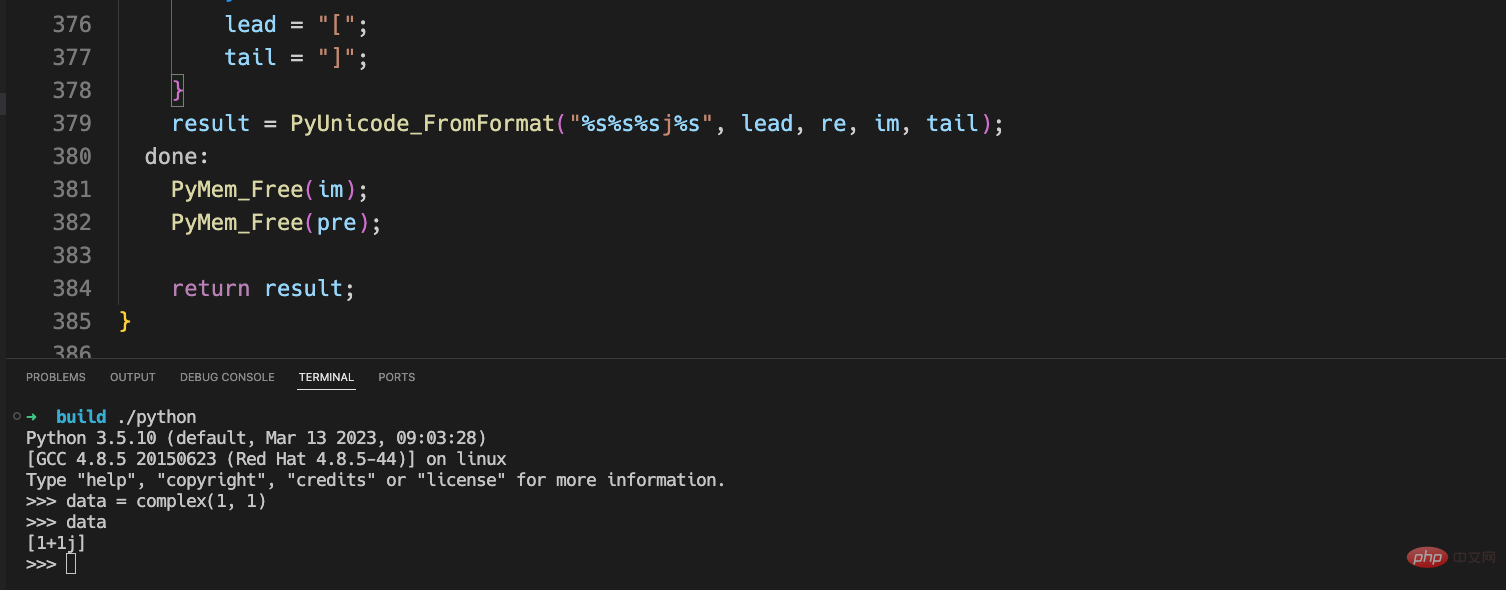Heim >Backend-Entwicklung >Python-Tutorial >Was ist das Implementierungsprinzip komplexer Zahlen in der virtuellen Python-Maschine?
Was ist das Implementierungsprinzip komplexer Zahlen in der virtuellen Python-Maschine?
- 王林nach vorne
- 2023-05-13 10:40:211497Durchsuche
复数数据结构
在 cpython 当中对于复数的数据结构实现如下所示:
typedef struct {
double real;
double imag;
} Py_complex;
#define PyObject_HEAD PyObject ob_base;
typedef struct {
PyObject_HEAD
Py_complex cval;
} PyComplexObject;
typedef struct _object {
_PyObject_HEAD_EXTRA
Py_ssize_t ob_refcnt;
struct _typeobject *ob_type;
} PyObject;上面的数据结构图示如下:

复数的数据在整个 cpython 虚拟机当中来说应该算是比较简单的了,除了一个 PyObject 头部之外就是实部和虚部了。
ob_refcnt,表示对象的引用记数的个数,这个对于垃圾回收很有用处,后面我们分析虚拟机中垃圾回收部分在深入分析。
ob_type,表示这个对象的数据类型是什么,在 python 当中有时候需要对数据的数据类型进行判断比如 isinstance, type 这两个关键字就会使用到这个字段。
real,表示复数的实部。
imag,表示复数的虚部。
复数的操作
复数加法
下面是 cpython 当中对于复数加法的实现,为了简洁删除了部分无用代码。
static PyObject *
complex_add(PyObject *v, PyObject *w)
{
Py_complex result;
Py_complex a, b;
TO_COMPLEX(v, a); // TO_COMPLEX 这个宏的作用就是将一个 PyComplexObject 中的 Py_complex 对象存储到 a 当中
TO_COMPLEX(w, b);
result = _Py_c_sum(a, b); // 这个函数的具体实现在下方
return PyComplex_FromCComplex(result); // 这个函数的具体实现在下方
}
// 真正实现复数加法的函数
Py_complex
_Py_c_sum(Py_complex a, Py_complex b)
{
Py_complex r;
r.real = a.real + b.real;
r.imag = a.imag + b.imag;
return r;
}
PyObject *
PyComplex_FromCComplex(Py_complex cval)
{
PyComplexObject *op;
/* Inline PyObject_New */
// 申请内存空间
op = (PyComplexObject *) PyObject_MALLOC(sizeof(PyComplexObject));
if (op == NULL)
return PyErr_NoMemory();
// 将这个对象的引用计数设置成 1
(void)PyObject_INIT(op, &PyComplex_Type);
// 将复数结构体保存下来
op->cval = cval;
return (PyObject *) op;
}上面代码的整体过程比较简单:
首先先从 PyComplexObject 提取真正的复数部分。
将提取到的两个复数进行相加操作。
根据得到的结果在创建一个 PyComplexObject 对象,并且将这个对象返回。
复数取反
复数取反操作就是将实部和虚部取相反数就可以了,这个操作也比较简单。
static PyObject *
complex_neg(PyComplexObject *v)
{
Py_complex neg;
neg.real = -v->cval.real;
neg.imag = -v->cval.imag;
return PyComplex_FromCComplex(neg);
}
PyObject *
PyComplex_FromCComplex(Py_complex cval)
{
PyComplexObject *op;
/* Inline PyObject_New */
op = (PyComplexObject *) PyObject_MALLOC(sizeof(PyComplexObject));
if (op == NULL)
return PyErr_NoMemory();
(void)PyObject_INIT(op, &PyComplex_Type);
op->cval = cval;
return (PyObject *) op;
}Repr 函数
我们现在来介绍一下一个有趣的方法,就是复数类型的 repr 函数,这个和类的 __repr__ 函数是作用是一样的我们看一下复数的输出是什么:
>>> data = complex(0, 1) >>> data 1j >>> data = complex(1, 1) >>> data (1+1j) >>> print(data) (1+1j)
复数的 repr 对应的 C 函数如下所示:
static PyObject *
complex_repr(PyComplexObject *v)
{
int precision = 0;
char format_code = 'r';
PyObject *result = NULL;
/* If these are non-NULL, they'll need to be freed. */
char *pre = NULL;
char *im = NULL;
/* These do not need to be freed. re is either an alias
for pre or a pointer to a constant. lead and tail
are pointers to constants. */
char *re = NULL;
char *lead = "";
char *tail = "";
// 对应实部等于 0 虚部大于 0 的情况
if (v->cval.real == 0. && copysign(1.0, v->cval.real)==1.0) {
/* Real part is +0: just output the imaginary part and do not
include parens. */
re = "";
im = PyOS_double_to_string(v->cval.imag, format_code,
precision, 0, NULL);
if (!im) {
PyErr_NoMemory();
goto done;
}
} else {
/* Format imaginary part with sign, real part without. Include
parens in the result. */
// 将实部浮点数变成字符串
pre = PyOS_double_to_string(v->cval.real, format_code,
precision, 0, NULL);
if (!pre) {
PyErr_NoMemory();
goto done;
}
re = pre;
// 将虚部浮点数变成字符串
im = PyOS_double_to_string(v->cval.imag, format_code,
precision, Py_DTSF_SIGN, NULL);
if (!im) {
PyErr_NoMemory();
goto done;
}
// 用什么括号包围起来
lead = "(";
tail = ")";
}
result = PyUnicode_FromFormat("%s%s%sj%s", lead, re, im, tail);
done:
PyMem_Free(im);
PyMem_Free(pre);
return result;
}我们现在修改源程序将上面的 () 两个括号变成 [],编译之后执行的结果如下所示:

可以看到括号变成了 [] 。
Das obige ist der detaillierte Inhalt vonWas ist das Implementierungsprinzip komplexer Zahlen in der virtuellen Python-Maschine?. Für weitere Informationen folgen Sie bitte anderen verwandten Artikeln auf der PHP chinesischen Website!

